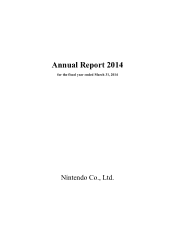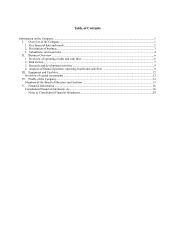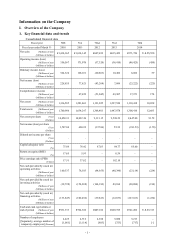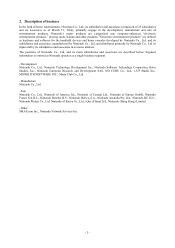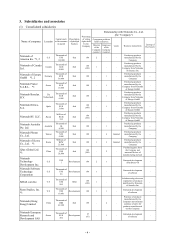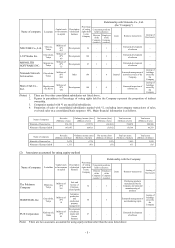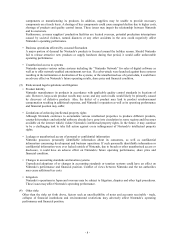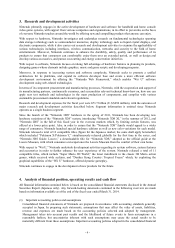Nintendo 2014 Annual Report Download - page 11
Download and view the complete annual report
Please find page 11 of the 2014 Nintendo annual report below. You can navigate through the pages in the report by either clicking on the pages listed below, or by using the keyword search tool below to find specific information within the annual report.- 9 -
3. Research and development activities
Nintendo primarily engages in the active development of hardware and software for handheld and home console
video game systems, with support from various companies and organizations, in its effort to put smiles on the faces
of everyone Nintendo touches around the world by offering new and compelling products that anyone can enjoy.
With respect to hardware, Nintendo investigates and undertakes research on fundamental technologies spanning
data storage technology such as semiconductor memories, display technology such as liquid crystal displays, and
electronic components, while it also carries out research and development activities to examine the applicability of
various technologies including interfaces, wireless communication, networks and security to the field of home
entertainment. Moreover, Nintendo continues to enhance the durability, safety, quality and performance of its
products to ensure that consumers can comfortably enjoy them over an extended period, as well as design and
develop various accessories, and pursue cost-cutting and energy conservation initiatives.
With respect to software, Nintendo focuses on taking full advantage of hardware features in planning its products,
designing games whose elements include graphics, music and game scripts, and developing programs.
Moreover, in response to increasing system and software complexity, Nintendo seeks to promote a unified
architecture for its platforms, and expand its software developer base and create a more efficient software
development environment by offering the “Nintendo Web Framework,” which enables “Wii U” software
development using web-related technologies.
In terms of its component procurement and manufacturing processes, Nintendo, with the cooperation and support of
its manufacturing partners, continuously examines, and accumulates relevant technical know-how on, how one can
apply new test methods and technologies in the mass production of components, and complies with various
sustainable procurement standards and relevant regulations.
Research and development expenses for the fiscal year were ¥71.7 billion (U.S.$696 million), with the outcomes of
major research and development activities described below. Segment information is omitted since Nintendo
operates as a single business segment.
Since the launch of the “Nintendo 3DS” hardware in the spring of 2011, Nintendo has been developing new
hardware variations of the “Nintendo 3DS” system, introducing “Nintendo 3DS XL” in the summer of 2012, and
“Nintendo 2DS” in the fall of this fiscal year in the overseas markets which, by limiting certain features, was
offered at a lower price point. Also, in order to ensure that the “Nintendo 3DS” family would appeal to a wider
range of consumers, Nintendo launched special hardware editions as well as new color variations for each model.
Nintendo released a total of 12 compatible titles (figure for the Japanese market; the same shall apply hereinafter)
which included “Pokémon X/Pokémon Y,” simultaneously released globally for the first time in the series, and
“Nintendo 3DS Guide: Louvre,” a downloadable title for “Nintendo 3DS,” adopted as the official guide at the
Louvre Museum, with which consumers can experience the Louvre Museum from the comfort of their own home.
With respect to “Wii U,” Nintendo undertook development activities regarding its system software, system features
and accessories in order to further enhance the user experience of the system. Nintendo released a total of 11
compatible titles, which include “Super Mario 3D World,” the latest installment in the classic 3D Mario action
games, which received wide acclaim, and “Donkey Kong Country: Tropical Freeze” which, by exploiting the
graphical capabilities of the “Wii U” hardware, offered dynamic gameplay.
Nintendo continues to engage in the development of new products for the future.
4. Analysis of financial position, operating results and cash flow
All financial information contained below is based on the consolidated financial statements disclosed in the Annual
Securities Report (Japanese only). Any forward-looking statements contained in the following overview are made
based on information available as of the end of the fiscal year ended March 31, 2014.
(1) Important accounting policies and assumptions
Consolidated financial statements of Nintendo are prepared in accordance with accounting standards generally
accepted in Japan. In preparing such statements, assumptions that may affect the value of assets, liabilities,
revenue and expenses are made based on the accounting policies selected and adopted by management.
Management takes into account past results and the likelihood of future events to form assumptions in a
reasonable fashion, but uncertainties inherent with such assumptions may cause the actual results to be
materially different from these assumptions. Important accounting policies adopted in the consolidated financial

